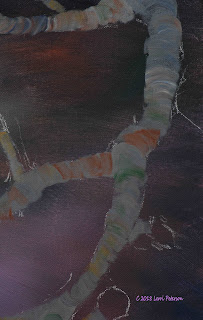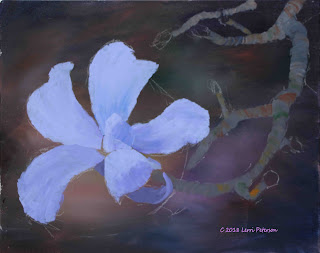This semester we will be learning about making a soft muddled background, negative space and creating the illusion of rounded tree branches.
Learning how to create a soft muddled background is very useful to any painter because many times you really do not want a busy background but you need something besides a stark white canvas. These kinds of backgrounds are good for still life, portrait even some landscapes need to have a soft out of focus background at times.
In acrylics we work from what is furthest away to what is closest. In this painting the out of focus tree branches, leaves and flowers are what is furthest away, that is where we start before we ever put a drawing on our canvas. You can paint right over acrylics so we do not need save areas like you would in watercolor or even oils, just paint all of the background.
You do need to work quickly to create this soft effect, to help keep your paints wet and to move them around the canvas, take your spray bottle and lightly spray the canvas, then, using a big brush such as a #12 flat bristle or your blending brush (we will use this brush shortly), pick up colors and start putting them on. I had my reference photo right in front of me so I could basically see where I had light and dark changes in the background and I loosely followed what I saw in the photo.
I am often ask "What colors will be be using?" to that I answer "All of them!" In the background you see above I think I used every color I had on my palette. I did use a lot of blue, bunt sienna or burnt umber for the dark areas, but I also used white (gesso), yellow, orange, red and green. Don't limit yourself when it comes to color, have all your colors out and ready to go when you start painting because you can save your paints from week to week if you store them properly, if you only put out what you think you might use, if you need something else, you won't stop to put it out, I know because I do it myself. Put out all your colors, problem solved.
Once you get the canvas covered - and it should all still be wet if you worked fast enough - get out your soft blending brush. You may want to lightly mist your canvas with water, just be sure that you work the mist in with your blending brush or you will get spots. Make sure that your blending brush is mostly dry if you have rinsed it out before using it on your painting. You will be making long crisscross strokes with your brush almost parallel to the canvas using very little pressure as you go.
Most students use their brush too upright with too much pressure and have problems making it work for them, you just want to skim the surface of the canvas, as the late Bob Ross would say "Three hairs and some air". Mist your paint if you need to, again, remember to work it in.
You can overwork this and end up with mud so stop when things look blurry, you are done. Let it dry then add your drawing. Because this is a dark background you can use white chalk so you can see it better, the chalk doesn't hurt anything.
Note that I have filled my canvas with the subject (see first image), I did this on purpose because it is the flower which is the most important, the branches are next, the background is just there for support. If I had made my design smaller the background, which is now the negative space, would over power what should be the most important part of my painting and make my painting much less interesting. By breaking the negative space up into interesting shapes with the flower and branches I use the negative space to my advantage,
 Now that the background is dry and I have my drawing on I can start the process of under painting the branches and the flower.
Now that the background is dry and I have my drawing on I can start the process of under painting the branches and the flower.Using my #4 flat sable brush, I mixed a gray using my ultramarine blue, burnt sienna (burnt umber will also work) and white to change the value. I used the width of the brush to make a series of slightly rounded strokes to form my branches. This as opposed to one solid brush stroke which can leave hard lines and look flat.
You want to always follow the shape of the thing you are painting with your brush strokes, in this case rounded branches.
In the flower petals I drew lines on some of them to show the direction, and in some cases directions, of my brush strokes.
To under paint the flower I was still using my #4 flat sable brush and I mixed my ultramarine blue with a tiny touch of purple to get a lavender color and gesso to make it light for the base color. Where the petals go in towards the center of if they go behind another petal and are darker, I added just a bit more blue to darken the color right on my canvas then blended it in with the base color.
Like the branches above, I used the edge of my brush and pulled in from the petal edge to form the edge with a series of strokes, on the inside of the petal my strokes followed the curves of the petal.
Now it might seem strange to start out with this lavender color for a white flower but it needs to happen this way so you have someplace to go with your highlights. Whenever you are painting white, you should start out with some form of light blue, lavender or gray so when you start highlighting the lighter colors will look light and your subject will have shape so it doesn't look flat, there is actually very little actual white on a subject.
 Try to have your painting to this point for our next class if you can, I will be finishing up the under painting for the flower and branches then start working on some detail.
Try to have your painting to this point for our next class if you can, I will be finishing up the under painting for the flower and branches then start working on some detail.Keep painting and I will see you in class.



No comments:
Post a Comment